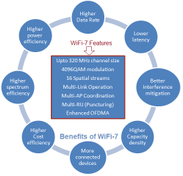Understanding WLAN Timers: TSF, NAV, Backoff, and More
Explore various WLAN timers defined in IEEE 802.11, including TSF, NAV, Backoff, ProbeDelay, SMK, MSDU, and MMPDU timers. Learn their functions and importance in WLAN operation.
Showing 20 posts (Page 4 of 6)
Advertisement
Explore various WLAN timers defined in IEEE 802.11, including TSF, NAV, Backoff, ProbeDelay, SMK, MSDU, and MMPDU timers. Learn their functions and importance in WLAN operation.

Explore WLAN (WiFi) technology, its 802.11 standards, architecture, protocols, QoS, security, and comparison with other wireless technologies.
Explore Wi-Fi 7 channel allocations, frequencies, and bandwidths. Understand how Wi-Fi 7 optimizes spectrum use and enhances data rates with features like Multi-Link Operation.

Learn about Wi-Fi Direct technology, which enables direct Wi-Fi connections between devices without an access point. Explore its benefits and applications.

Explore the differences between WiFi 4 (802.11n) and WiFi 5 (802.11ac), including speed, range, bandwidth, and other parameters.

Explore the key differences between WiFi 6 and WiFi 7, including data rates, frequency bands, modulation, MIMO, and channel size.

Explore the pros and cons of WiFi 6E, an extension of WiFi 6 using the 6 GHz band, offering faster speeds, lower latency, and improved performance.

Explore WiFi 7 Multi-Link Operation (MLO) for increased data rates, lower latency, and improved reliability. Learn about MLO modes, architecture, and benefits as per the IEEE 802.11be standard.
Explore the similarities and differences between WiFi 7 (802.11be) and WiFi 8 (802.11bn), focusing on data rates, features, and target applications.

Explore WiFi 7 (IEEE 802.11be), its key features like 320 MHz channels, 4096 QAM, MU-MIMO, and Multi-Link Operation, and the benefits it offers over previous WiFi generations.
Explore the distinctions between WiFi extenders and routers in terms of coverage, internet connectivity, standalone operation, ports, and cost. Understand how they work together to enhance WiFi.

Explore the evolution of WiFi technology, from the original 802.11b to the latest WiFi 6 (802.11ax). Compare speeds, range, and key features across all generations.
Explore WiFi HaLow (WiVi) technology, designed to extend WiFi coverage with low power consumption. Learn about its features, specifications, and applications in IoT networks, adhering to the IEEE 802.11ah standard.

Explore WiFi hotspots for wireless internet access, their setup, and future trends, including WiFi boosters and repeaters for extended coverage.

Explore WiFi Quality of Service (QoS) as defined by IEEE 802.11e, including WME/WMM and WSM, to enhance performance for voice, video, and other applications in WLAN networks.

Learn the fundamentals of WiFi roaming, including internal and external roaming types, how the process works, and the roles of STAs, APs, and AS.

Explore a comprehensive list of WiFi router manufacturers and vendors, covering WLAN standards, specifications, and key features.
Explore difference between Wi-Fi Shield used in 802.11be (WiFi-7) and traditional encryption techniques such as WPA2 and WPA3 used in previous versions of WLAN standards.

Explore the fundamentals of WiFi sniffers, their operation, and a list of vendors providing WiFi sniffer solutions.

A WiFi USB adapter allows devices to connect to WiFi networks. It enables wireless data exchange, extending connectivity to devices without built-in WiFi.
Advertisement